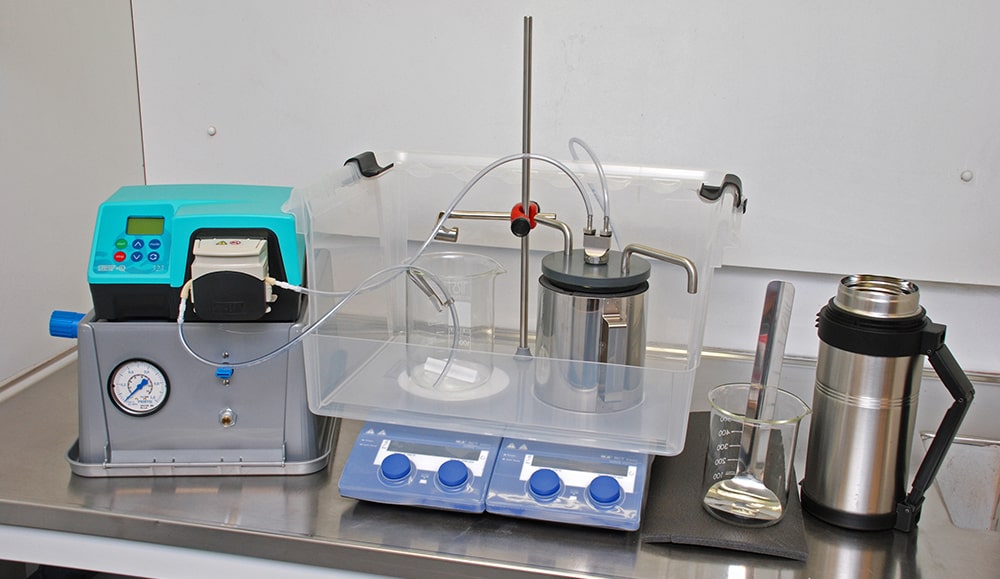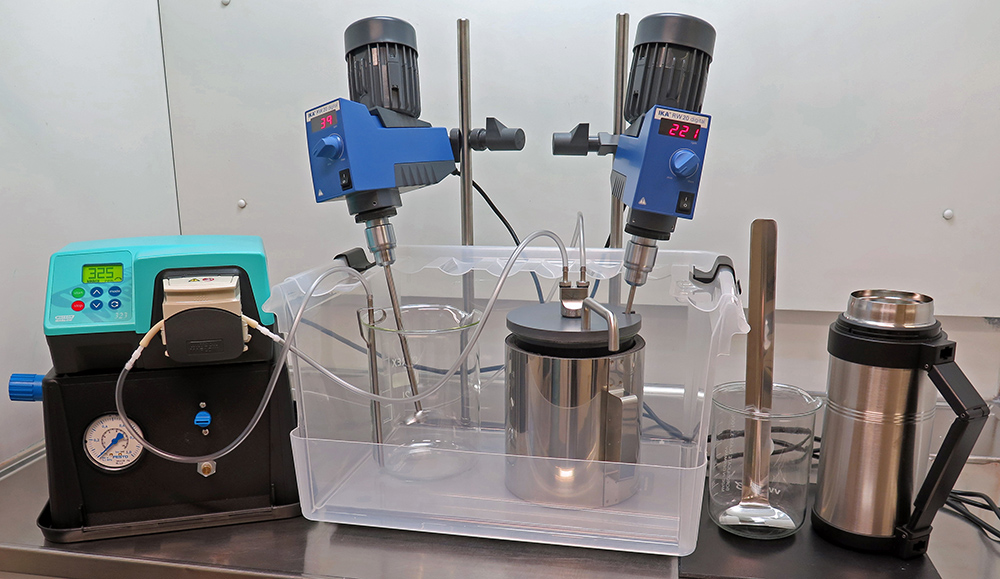
Lab-scale Granulators
We have two different lab-scale granulators: LS-6 and LS-6nms
Lab-scale granulators using magnetic or impeller stirring with capacity of processing small batches of down to 50 ml as well as up to several liters in a day depending on the material and suspension properties.
Spherical and homogeneous granules with
- No contamination
- No migration of binders or small particles
- No void formation
- No formation of dried shell
- Re-dispersible nano-sized powders and enzymes
- Equipment easy to use and easy to clean
- Small or larger suspension batches is processed with the same granule size distribution and internal granule homogeneity
- Granule size from 10 to 700 μm
- Low waste of material (high yield)
- Low temperature granulation for temperature sensitive materials
- Granulation of 10 small test batches of different compositions can be done in 4h including cleaning time
- Processing capacity is dependent on volume concentration of powder in slurry and granulation setting
- Superior for retaining homogeneity in mixed material powders
LS-6 and LS-6nms
LS-2, our former smallest freeze granulator, enables a suspension feeding of up to 2 liter/h. In practice, it allows processing of about 1 liter/h including the handling of frozen granules. In similarity, the larger granulator LS-6 enables a suspension feed of up to 6 liter/hour and a corresponding processing capacity of about 3 liter/h.
The given processing capacities for LS-6 is based on suspension volume. The corresponding output capacity in dry weight depends on the density of the specific material and the loading of it in suspension. This means that it could be a large variation on weight basis to be related to the stated processing capacity in suspension volume per hour.
LS-6nms is an LS-6 version equipped with impeller instead of magnetic stirrers, aimed for processing of magnetic powder materials that will be stacked to the magnet. It can also be used when heavy powder materials are to be processed and the magnetic stirring capacity considered to be limited.
Granulation
Upon freeze granulation of one liter suspension with 40 vol% solids, the consumption of liquid nitrogen is 4-5 liters and the volume of frozen granules will approximately be two liters.
After the granulation the frozen granules have to be dried by utilizing a freeze dryer with a capacity that match the daily production volume. PowderPro provides a lab-scale freeze dryer, Alpha 1-4 LSCplus with a capacity to dry frozen granules derived from 1-1.5 litre suspension in 24 hours. In practice the drying time depends on how much frozen liquid (water or solvent) is to be removed, in other words, depends on how high the powder content is in the processed suspension. For the need of higher drying capacity, a wide range of freeze dryers exist on the market.
The granule size distribution is not depending on nozzle size. The spray settings, liquid flow versus gas pressure sets size. Higher air pressure or lower liquid flow gives finer spray.
Dry granules may need sieving to the range necessary for subsequent processing. Excess powder is easy to re-dissolve in water and re-granulated (next batch). Moist is very low after drying in vacuum. It may adsorb moist from atmosphere if exposed.
To process 1 liter slurry in the lab, setup, freezing, loading dryer and cleanup is about 1 hour work. Drying is about 24 hours. One liter slurry (600 cc H2O) consumes 4-5 liters liquid Nitrogen.
Installation
Installation, demonstration and training is done online after the equipment has been delivered. At this occasion any of your material can be processed. The cost for the Lab-scale Granulator cover and includes the accessories you need for running the equipment.
Lab-resources needed
Ventilation, pressurized air and for the processing you need access to liquid nitrogen. It can also be convenient to have a freezer for storage of frozen granules, can be a simple house-hold version.
Examples of granule production in weight
- Typical submicron ceramic powder with a density of 4 g/cm3: 35 vol% powder loading in suspension corresponds to 1.4 kg output in dry weight per liter processed suspension.
- Ceramic nano-powder with a density of 4 g/cm3: 5 vol% powder loading in suspension corresponds to 0.2 kg dry weight per liter processed suspension.
- Steel powder (gas atomized) with a density of 8 g/cm3: 45 vol% powder loading in suspension corresponds to 3.6 kg dry weight per liter processed suspension.
- Organic material with a density of 1 g/cm3: 20 vol% powder loading in suspension corresponds to 0.2 kg dry weight per liter processed suspension.


